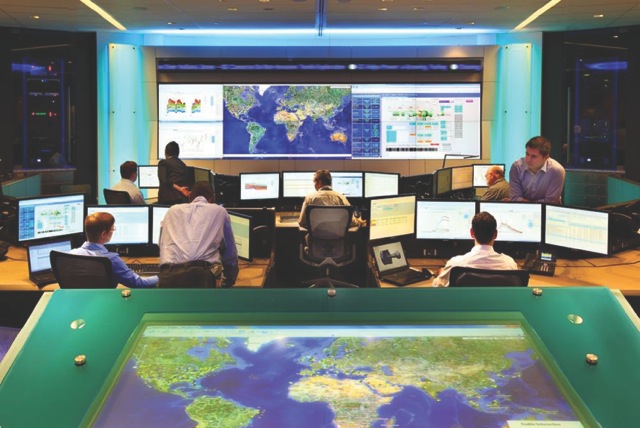Managers at command and control centers perhaps have the longest history, most experience and greatest agility when it comes to managing mobile communications. We've asked some of the people responsible for developing command and control room solutions to provide some insight and best practices.
Contemporary Lifecycle Planning Essentials
"The next generation of command and control is characterized by the proliferation of personal information devices and an increasingly decentralized workforce," said CineMassive strategist, Business Development, Katie Barter.
To succeed in these new conditions, control room managers must have dynamic tools that enable them to aggregate information from disparate, physically separate sources and disseminate information back out to relevant stakeholders, regardless of their information viewing device or physical location. "As device display resolutions and information consumption rates continue to increase, information systems will continue on a trajectory towards ever-higher information density," Barter notes. "Modern information systems need to anticipate future bandwidth requirements and embrace fiber optic infrastructure rather than copper wherever possible."
Plan for what is going to be needed two years from now, Bob Ehlers, vice president, Marketing and Vertical Market Development, at RGB Spectrum, said. "If I’m building a command center, it assumes that we’re going to be using cell phone technology as a client of the information that I’m managing. It’s not if, but when."
Ehlers urged, "You need to make sure you have the capacity to handle all of these devices on the out-bound side. On the in-bound side, with the Internet of Things, everything is going to be reporting its status; everything is a sensor, so that means I’m going to have a lot more information coming in, and I’m going to have a lot more summarization that’s going to have to happen." That big data is just going to get bigger.
Mobility Means Latency
The question of remote connectivity and video imaging quality, Ehlers said, "comes down to requirements around latency, and there are tradeoffs. I can send you a very pristine, very high-quality, lightweight compressed image in 10 megabits per second, or I can send you the same image that may still be useful for you in a much smaller 1 or 2 megabits per second."
During the planning process the discussion of what is important needs to happen; "bandwidth consumption, speed of delivery or latency, or video quality," Ehlers said.
Remote Control Rooms Offer Scalability
Darrin Thurston, vice president of Engineering at Vaddio, talks about how companies can benefit from consolidating control rooms designed to monitor meeting rooms and classroom, video collaboration and production activities.
Rather than physically going to the meeting room when there is a scheduled meeting, a remote network operator can make sure the room is up and going. He looks into the room remotely, puts the cameras where they need to be and checks the audio. There are a lot of instances where it's just a maintenance check.
"The nice thing about virtualization is that it is not a physical limitation of my cabling at that point. It gives you the ability to scale. For instance, one operator may be able to handle four rooms if there's not a lot of interaction in the classroom; one professor may be lecturing and there maybe there three or four camera shots, a couple of audio transitions."
Thurston says that as you scale down, the actual day-to-day management of it [remote AV control] will fall to the IT department. They might not know the ins and outs of how AV works, but [that ’s why] you have simplified control. You don't need to don't know a lot about AV to drive a camera. The joystick and interface are very intuitive. However, if you are an AV person, there are more advance features if you want to up the quality of production, you have access to that.
"Paired with that are the enterprise and device management functions to notify the health of your system. If I am 'remoting' my operations, I need to have the ability to send the diagnostics information to me. If a particular piece of equipment failed or was having an issue, you're not physically in the room to check that."
Cindy Davis is a regular AV Technology magazine contributor.
Pictured: a command & control center supported by Technical Innovation.
Mission-Critical Managed Service
by Kevin Powers
- Many of our clients have made significant investments in network-based collaborative technologies, as it relates to their mission critical facilities. On the backside of that investment they realize they don’t have the subject matter expertise in-house resident in their IT organizations to deliver highly reliable support. That’s when they turn to TI. We are engaged with multiple clients today who we support with an on-site technician with expertise specific to their needs, relieving them of the burden to develop the expertise on their own. In a mission critical environment where there is no margin for error, having a certified TI technician on premises provides our clients with immediate response to any system disruptions, an improvement in productivity, as well as proactive maintenance and lifecycle management…..all resulting in peace of mind.
- Key considerations for on-site managed services in a mission critical facility:
· Places a first responder on premises to instantaneously address any system disruption
· Certified technician with skill sets and security clearance matched to the requirements of your AV/IT infrastructure
· ROI realized through an increase in operational efficiencies and productivity
· Preventative Maintenance
· Asset Management/Equipment Lifecycle Management
· Relief from hiring and certifying qualified technical personnel & associated staffing expenses
Visit technical-innovation.com for more information.

